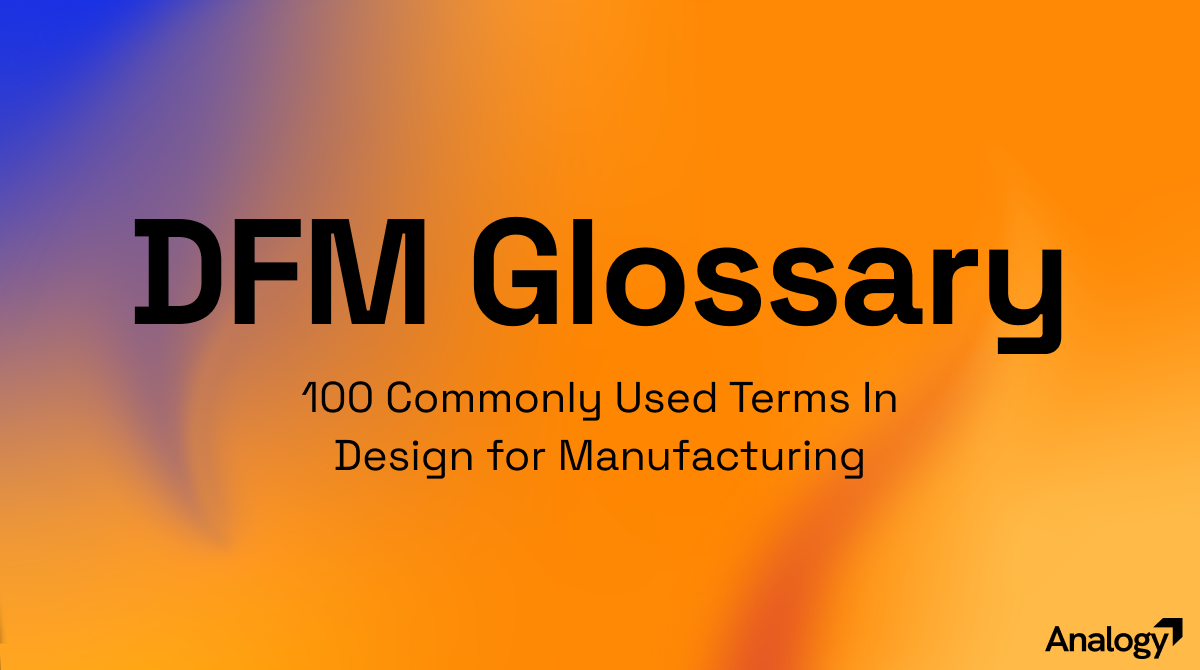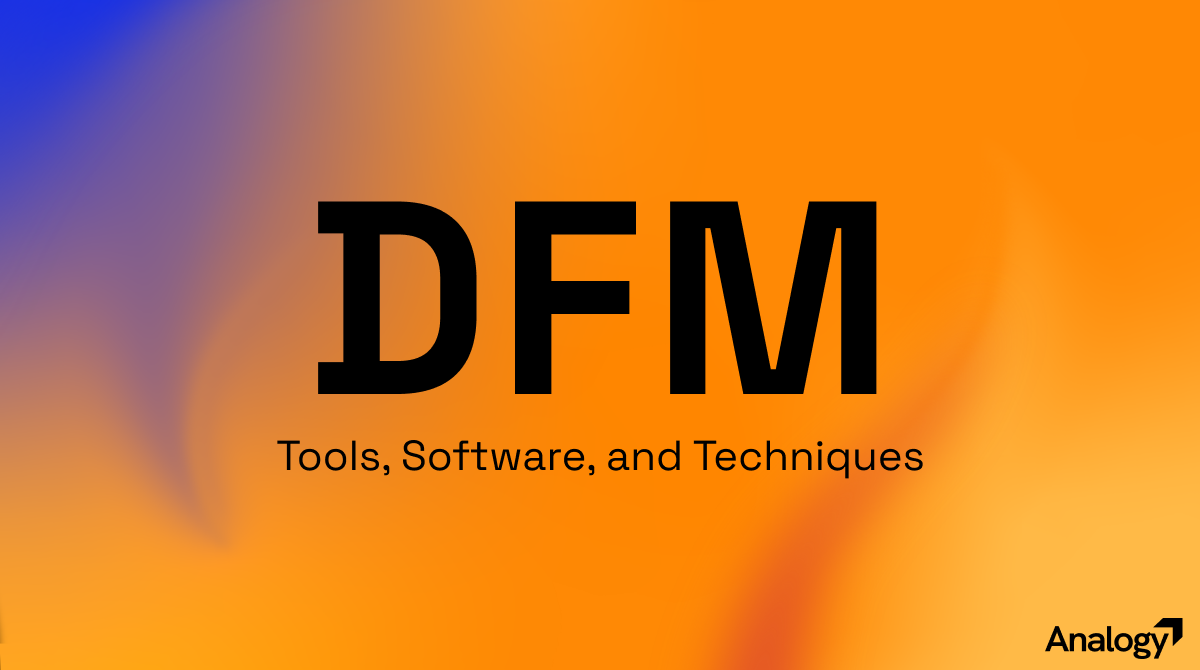
100 Commonly Used Terms In Design for Manufacturing (DFM)
As a product designer, you must be well acquainted with terms that are commonly used in the Design for Manufacturing (DFM) space. We have curated a huge list of terms used in the product design or industrial design space. You can learn, memorize and remember them so you can use them at work.
This article is a part of the Design for Manufacturing (DFM) series
- Design for Manufacturing (DFM) Complete Guide – Analogy
- DFM Glossary: 100 Commonly Used Terms In Design for Manufacturing
- DFM Examples: Real World Case Studies & Visual Gallery
- DFM Checklist: Design for Manufacturing Best Practices
- DFM Mistakes: 50 Common DFM Mistakes You Must Avoid
- DFM Tools: 50 DFM Tools, Software, and Techniques
Below is a list of 100 most commonly used terms in the Design for Manufacturing (DFM) space:
Manufacturability
This is about how easily a product can be made. A manufacturable design reduces production time and cost. It ensures the product can be built reliably at scale.
Tolerance
Tolerance is the allowable variation in a part’s dimensions. It ensures that parts fit together properly during assembly. Tight tolerances increase precision but may raise costs.
Assembly
Assembly is the process of joining parts to create the final product. Simplifying assemblies can reduce time and errors. Good assembly design makes manufacturing smoother.
Prototype
A prototype is an early version of a product used for testing. It helps identify design or manufacturability issues. Prototypes can be made with 3D printing or CNC machining.
CAD (Computer-Aided Design)
CAD is software used to create 2D or 3D digital models. Designers and engineers use CAD to plan parts, assemblies, and production. CAD helps identify potential manufacturing problems early.
Material
Material is the substance used to make a product, like plastic, metal, or wood. Choosing the right material affects durability, cost, and manufacturability. Some materials are easier to process than others.
Fastener
A fastener is hardware like screws, bolts, or snaps used to join components. Choosing the right fastener simplifies assembly and improves product strength. Fasteners are a key part of DFA considerations.
Cost Optimization
Cost optimization is the practice of reducing production expenses without sacrificing quality. Designers select efficient materials and processes to save money. It makes products profitable and competitive.
DFMA
DFMA stands for Design for Manufacture and Assembly. It combines DFM and DFA to optimize both manufacturing and assembly. Using DFMA helps reduce part count and production time.
Feasibility
Feasibility is checking whether a design can actually be made. It considers materials, processes, and assembly methods. Feasibility analysis prevents costly mistakes later.
Draft Angle
Draft angle is the slight slope on vertical faces of molded parts. It helps parts come out of molds easily. Without proper draft angles, production can be difficult.
Wall Thickness
Wall thickness is how thick a part’s surface is. Uniform wall thickness improves strength and reduces warping. It also makes parts easier to manufacture.
Rib
A rib is a structural feature added to strengthen thin walls. It prevents bending or flexing without adding too much material. Ribs are commonly used in plastic parts.
Snap-Fit
Snap-fits are connectors that hold parts together without screws. They simplify assembly and reduce labor time. Snap-fits must be carefully designed to avoid breakage.
Screw
Screws are a common type of fastener. They are easy to use but may add assembly time. Choosing screws wisely affects both DFM and DFA.
Injection Molding
Injection molding is a manufacturing process for shaping plastics. Molten plastic is injected into a mold to form a part. It is widely used for high-volume production.
CNC Machining
CNC machining uses computer-controlled tools to cut parts. It is precise and suitable for metals and plastics. CNC is often used for prototypes and low-volume production.
Die Casting
Die casting is a process where molten metal is forced into a mold. It produces strong, detailed metal parts efficiently. Die casting is common in automotive and electronics.
Sheet Metal
Sheet metal refers to thin metal sheets shaped into parts. Bending, stamping, and cutting are common processes. Sheet metal designs must consider manufacturability and assembly.
Surface Finish
Surface finish is the texture of a part’s exterior. Smooth finishes can improve aesthetics and reduce friction. Different finishes may affect cost and production method.
Part Count
Part count is the total number of pieces in a product. Reducing part count simplifies assembly and lowers manufacturing cost. Fewer parts usually mean faster production and fewer errors.
Tooling
Tooling refers to the molds, dies, jigs, and fixtures used in manufacturing. Proper tooling ensures parts are made accurately and consistently. It is a critical part of DFM planning.
Mold
A mold is a shaped cavity used to form parts, usually in plastics or metal casting. Well-designed molds make production faster and reduce defects. Mold design is closely tied to draft angles and wall thickness.
Process Flow
Process flow is the step-by-step sequence used to manufacture a product. A smooth flow reduces delays and errors. DFM considers process flow to make production efficient.
Production Line
A production line is the setup where products are assembled or manufactured. Optimizing the line improves speed, quality, and cost. DFM ensures products fit the line’s capabilities.
Lead Time
Lead time is the total time from design to finished product. Reducing lead time helps get products to market faster. DFM helps minimize delays by simplifying production steps.
Cycle Time
Cycle time is the time it takes to make one unit of a product. Shorter cycle times reduce cost per unit. DFM looks for ways to streamline manufacturing to improve cycle time.
Tolerance Stack-Up
Tolerance stack-up is the accumulation of small variations across parts. It can cause assembly problems if not managed. DFM analyzes stack-ups to ensure parts fit correctly.
Fitment
Fitment refers to how well parts fit together. Proper fitment avoids gaps, misalignment, or mechanical issues. DFM ensures parts are designed to fit reliably.
Assembly Time
Assembly time is how long it takes to put a product together. Minimizing assembly time saves labor costs. DFA principles often guide ways to reduce assembly time.
Process Simulation
Process simulation uses software to predict manufacturing outcomes. It helps detect issues before production. Simulations save cost and reduce prototyping iterations.
Quality Control
Quality control ensures products meet specifications. It includes inspection, testing, and verification. DFM designs parts to be easier to check and maintain high quality.
Inspection
Inspection is the process of checking parts for defects or errors. It ensures that only acceptable products move forward. DFM can simplify inspection by standardizing features.
BOM (Bill of Materials)
BOM is a list of all parts and materials needed for a product. It helps plan manufacturing and manage inventory. A clear BOM supports efficient production and cost control.
DFM Guidelines
DFM guidelines are best practices for creating manufacturable designs. They cover materials, tolerances, assembly, and processes. Following these guidelines reduces risk and production issues.
DFA Principles
DFA principles help designers create products that are easy to assemble. They focus on reducing parts, choosing efficient joining methods, and minimizing labor. DFA is a key part of DFMA.
Material Selection
Material selection is choosing the right material for parts. It impacts strength, cost, aesthetics, and manufacturability. DFM evaluates materials to balance performance and production ease.
Product Lifecycle
Product lifecycle is the total life of a product from design to disposal. Considering lifecycle helps in planning for sustainability and maintenance. DFM ensures manufacturability throughout the lifecycle.
Prototyping Method
Prototyping methods are techniques used to create early models. Examples include 3D printing, CNC, and soft tooling. DFM ensures prototypes reflect manufacturability concerns.
Pilot Production
Pilot production is a small-scale manufacturing run before full-scale production. It tests assembly processes, quality, and tooling. DFM feedback is critical at this stage to fix issues early.
Mass Manufacturing
Mass manufacturing is producing large quantities of a product efficiently. It requires consistent quality and streamlined processes. DFM ensures the product design can be scaled to high volumes without issues.
Additive Manufacturing
Additive manufacturing, or 3D printing, builds parts layer by layer. It allows for complex shapes and rapid prototyping. DFM evaluates whether additive methods are suitable for the design.
Subtractive Manufacturing
Subtractive manufacturing removes material from a solid block to create parts. CNC machining is a common example. DFM considers subtractive methods for precision and efficiency.
Rapid Prototyping
Rapid prototyping quickly creates a model to test form, fit, or function. It speeds up design validation and early DFM feedback. Rapid prototypes help identify manufacturability issues before full production.
Machinability
Machinability is how easily a material can be cut or shaped. Materials with good machinability reduce tool wear and production time. DFM considers machinability when selecting materials.
Manufacturable Design
A manufacturable design is created with production in mind. It simplifies parts, optimizes tolerances, and reduces errors. DFM ensures concepts are not only functional but also buildable.
DFMA Analysis
DFMA analysis evaluates a product for both manufacturing and assembly efficiency. It identifies ways to reduce parts, cost, and assembly time. DFMA combines DFM and DFA into one practical review.
Product Optimization
Product optimization improves performance, cost, and manufacturability. It balances functionality, aesthetics, and production efficiency. DFM feedback is central to this process.
Design Iteration
Design iteration is the process of refining a design through multiple versions. Each iteration incorporates feedback and manufacturability considerations. Iteration ensures the final product is both innovative and buildable.
Engineering CAD
Engineering CAD is the detailed digital model used for mechanical design. It includes precise dimensions, assembly information, and tolerances. DFM uses CAD to validate manufacturability.
Drafting Standards
Drafting standards are rules for creating clear and consistent technical drawings. They ensure all team members understand part geometry. Following standards helps prevent manufacturing errors.
Dimensional Accuracy
Dimensional accuracy is how close a part’s actual measurements are to its design. High accuracy ensures proper assembly and function. DFM evaluates tolerances to maintain accuracy.
Cost Reduction
Cost reduction is minimizing production expenses while maintaining quality. DFM identifies design changes that save material, simplify assembly, or speed up production. Lower cost improves product competitiveness.
Risk Mitigation
Risk mitigation is identifying and addressing potential manufacturing or assembly problems. DFM helps reduce errors, delays, and defects. Early mitigation prevents costly issues during mass production.
Design Validation
Design validation ensures the product meets performance and manufacturability requirements. Prototypes, simulations, and testing are used. DFM principles guide this validation process.
Manufacturability Index
A manufacturability index is a measure of how easy a product is to make. Higher scores indicate simpler, more efficient production. DFM uses it to compare design options.
Feature Simplification
Feature simplification removes unnecessary complexity from parts. It makes production faster and assembly easier. DFM encourages simple, functional designs.
Part Consolidation
Part consolidation combines multiple components into one to reduce assembly complexity. It decreases cost and assembly time. DFMA reviews often suggest consolidation opportunities.
Lean Manufacturing
Lean manufacturing focuses on eliminating waste and maximizing efficiency. DFM complements it by designing parts and assemblies for smooth production. Together, they improve cost and quality.
Concurrent Engineering
Concurrent engineering is when design and manufacturing teams work together from the start. It shortens development time and reduces errors. DFM is a key tool in this collaborative approach.
Product Brief
A product brief outlines the goals, requirements, and vision for a product. It guides design, engineering, and manufacturing decisions. DFM considerations start early by reviewing feasibility in the brief.
Use Case
A use case describes how a product will be used by its target audience. It helps identify functional requirements and constraints. DFM ensures the design is manufacturable while meeting these use cases.
Assembly Fixture
An assembly fixture holds parts in place during assembly. It improves accuracy, speed, and safety. DFM designs products to fit standard fixtures whenever possible.
Toolpath
A toolpath is the route a machine follows to cut or shape a part. Optimized toolpaths reduce machining time and waste. DFM ensures part geometry supports efficient toolpaths.
Tolerance Analysis
Tolerance analysis studies how part variations affect fit and function. It prevents assembly issues and ensures reliability. DFM uses tolerance analysis to create precise designs.
Process Capability
Process capability measures how well a manufacturing process can produce parts within specifications. High capability reduces defects. DFM designs parts to match process capabilities.
Scale-Up
Scale-up is increasing production from prototype or pilot runs to mass manufacturing. DFM ensures the design can handle larger volumes without issues. Scale-up planning avoids bottlenecks and defects.
Modular Design
Modular design breaks a product into independent, interchangeable modules. It simplifies assembly, repair, and upgrades. DFM evaluates modules for manufacturability and assembly efficiency.
Product Ecosystem
A product ecosystem is the network of parts, systems, and processes that support a product. Considering the ecosystem ensures compatibility and efficiency. DFM helps integrate designs seamlessly into this ecosystem.
Fit and Function
Fit and function describe how well parts connect and perform their intended purpose. DFM ensures dimensions and tolerances allow proper fit. Proper design guarantees reliable product function.
Thermal Management
Thermal management controls heat within a product. Proper design prevents overheating and ensures durability. DFM incorporates materials and structures that support effective cooling.
EMI/EMC Consideration
EMI (Electromagnetic Interference) and EMC (Electromagnetic Compatibility) affect electronic product performance. DFM ensures designs minimize interference and meet compliance. Early consideration avoids costly redesigns.
Assembly Strategy
Assembly strategy is the plan for how parts will be put together. It defines order, methods, and tools needed. DFM reviews ensure the strategy is simple and efficient.
Fastening Method
Fastening method is how parts are joined, using screws, clips, adhesives, or snaps. DFM evaluates the best option for strength and ease of assembly. The right method reduces errors and time.
Poka-Yoke
Poka-Yoke is a design approach that prevents errors during manufacturing or assembly. It makes it easy to assemble parts correctly the first time. DFM incorporates Poka-Yoke to improve quality.
Error Proofing
Error proofing is designing parts or processes to avoid mistakes. It reduces defects and production delays. DFM uses error-proof features to improve manufacturability.
Surface Treatment
Surface treatment modifies the exterior of a part for protection or aesthetics. Examples include painting, anodizing, or plating. DFM ensures treatments are compatible with materials and processes.
Paint/Coating
Paint and coating add color, protection, or texture to a part. DFM considers application methods and durability requirements. Proper planning prevents finish defects during mass production.
Plating
Plating is applying a thin metal layer to a surface for protection or appearance. DFM evaluates plating feasibility on complex shapes. It ensures consistent coverage without affecting tolerances.
Gloss/Matte Finish
Gloss or matte finish affects a product’s visual appeal. DFM ensures surface design and material selection allow the intended finish. Consistent finishes maintain brand quality and aesthetics.
Structural Integrity
Structural integrity is the ability of a part or product to withstand forces without breaking. DFM ensures parts are strong enough for intended loads. Proper material choice and design maintain integrity during use.
Load-Bearing Design
Load-bearing design focuses on parts that carry weight or stress. DFM ensures these parts are strong and manufacturable. Accurate calculations prevent failure and ensure safety.
Design Constraints
Design constraints are limits like size, weight, cost, or materials. DFM takes these into account to create practical, manufacturable designs. Constraints guide decisions without stifling creativity.
Standardization
Standardization is using common parts, materials, or processes across products. It reduces cost, simplifies assembly, and improves reliability. DFM encourages standardization whenever possible.
Component Library
A component library is a collection of pre-designed parts. Using it saves time and ensures compatibility. DFM leverages libraries to maintain manufacturability and quality.
CAD Export
CAD export is saving a design in a format that can be used by other software or machines. It ensures smooth handoff to manufacturing. DFM considers export compatibility to prevent errors.
Gerber File
A Gerber file is the standard format for PCB manufacturing. It contains all the data needed to make the board. DFM ensures PCB designs are optimized for production.
Wiring Harness
A wiring harness is an organized bundle of wires and connectors. DFM ensures harnesses are manufacturable and easy to assemble. Proper design prevents electrical failures.
Bill of Materials Optimization
Optimizing the BOM reduces unnecessary parts or materials. It simplifies assembly and lowers cost. DFM uses BOM optimization to improve efficiency and manufacturability.
Testability
Testability is how easy it is to inspect or test a product. DFM designs parts for accessible test points and diagnostics. High testability reduces defects and maintenance issues.
Serviceability
Serviceability is how easy it is to repair or maintain a product. DFM ensures parts can be replaced or accessed without difficulty. Good serviceability extends product life and customer satisfaction.
Manufacturability Feedback
Manufacturability feedback is input from engineers about how easy a design is to make. It identifies potential problems early. DFM uses feedback to refine parts and processes.
Design Review
Design review is evaluating a product’s design for functionality, quality, and manufacturability. It helps catch issues before production. Regular reviews save cost and time.
Product Reliability
Product reliability is the ability to perform consistently over time. DFM ensures designs are durable and resistant to failure. Reliable products enhance brand trust and customer satisfaction.
Version Iteration
Version iteration is creating successive updates of a design. Each iteration improves manufacturability, function, or cost. DFM ensures each version is production-ready.
Vendor Coordination
Vendor coordination is working with suppliers to source materials or parts. DFM helps communicate design requirements clearly. Proper coordination prevents delays and defects.
Packaging Design
Packaging design protects the product and makes it ready for shipping. DFM ensures the product fits safely and efficiently in packaging. It also considers assembly, cost, and presentation.
Certification
Certification ensures a product meets safety, quality, or regulatory standards. DFM ensures designs comply with certifications like CE, BIS, or ISO. Compliance reduces legal risk and improves market acceptance.
Production Efficiency
Production efficiency is achieving the highest output with the least waste. DFM improves efficiency by simplifying parts, assembly, and processes. Efficient production reduces cost and lead time.
Market-Ready Product
A market-ready product is fully designed, manufactured, and tested for sale. DFM ensures the product can be produced at scale while maintaining quality. It bridges the gap between design intent and real-world production.
Prototype Testing
The process of evaluating a prototype to check functionality, fit, and manufacturability. It helps identify design issues early. Prototype testing reduces risks before full production.
Tolerance Analysis Software
Software used to simulate how variations in part dimensions affect assembly and performance. It helps prevent misalignment and assembly failures. DFM uses it to validate tolerances before production.
Kitting
Kitting is grouping all parts needed for assembly into a single package. It speeds up assembly and reduces errors. DFM considers kitting to improve production workflow.
Tool Wear
Tool wear is the gradual degradation of manufacturing tools over time. Excessive wear affects accuracy and quality. DFM considers tool longevity when designing parts and processes.
Process Standardization
Standardizing processes ensures consistent quality and efficiency across production. DFM incorporates standardization to minimize errors and reduce variation.
Design Freeze
Design freeze is the point at which the product design is finalized before production. It prevents unplanned changes that could disrupt manufacturing. DFM ensures the design is manufacturable before freezing.
Assembly Sequence
Assembly sequence is the planned order of putting parts together. Optimizing the sequence reduces assembly time and errors. DFM aligns design features with an efficient sequence.
DFM Checklist
A DFM checklist is a list of criteria used to review designs for manufacturability. It ensures nothing is overlooked in the Design for Manufacturing process. Using a DFM checklist improves consistency and production readiness.
Conclusion: Mastering the Language of DFM
Understanding the terminology of Design for Manufacturing is more than memorizing words, it’s about speaking the language of product creation. When you know these key terms, you can communicate effectively with engineers, manufacturers, and design teams, ensuring that your ideas are translated into real-world products without missteps. This knowledge empowers you to anticipate production challenges, make smarter design decisions, and collaborate more confidently across disciplines.
By familiarizing yourself with these 100 commonly used DFM terms, you equip yourself with the tools to bridge design and manufacturing seamlessly. Whether you are sketching your first concept or refining a mass-production-ready prototype, this glossary serves as a reference and guide. Over time, these terms become second nature, helping you navigate product development with clarity, efficiency, and authority.
About The Authors

Vyasateja Rao – Founder, Analogy
Vyasateja Rao is a multi-award-winning product designer with over two decades of experience, and the visionary founder of Analogy, a Bangalore-based industrial and interaction design studio. He specializes in crafting memorable and innovative experiences for both physical and digital products. After earning a Masters in Industrial Design from North Carolina State University in 2007, Vyasateja worked across the United States, Hong Kong, China, Korea, Taiwan, Singapore, and India, collaborating with Fortune 500 companies and leading design studios. His studio has received international recognition, including the Red Dot, IBDC, Singapore Design Award, and multiple patents for product innovation. Vyasateja has designed for global clients such as Panasonic, Unilever, Amazon, Marvel, and Cellairis, blending creativity with manufacturability to create breakthrough products. Beyond design, he mentors aspiring designers, teaching the importance of contrast, surprise, and hidden artifacts in creating compelling experiences.

Dinesh Krishnamoorthy – Lead Design Engineer, DFM Expert
Dinesh Krishnamoorthy is a Design for Manufacturing (DFM) specialist with 9 years of experience in product engineering and production optimization. He graduated with a B.E. in Mechanical Engineering from Dhanalakshmi Srinivasan Engineering College (Anna University), Perambalur, and began his career as a Quality Engineer. His passion for design led him to Butterfly Gandhimathi Appliances Ltd, where he gained hands-on experience in both product design and manufacturing. This exposure shaped his deep understanding of DFM principles, learning directly from mold designers and production teams. At Analogy, Dineshkumar integrates manufacturing considerations from the earliest design stages, ensuring efficient, cost-effective, and production-ready products. He believes DFM transforms CAD designs into real, launch-ready products, making the engineering process smoother and more impactful.
FAQs
news & insights
Continue reading

Design for Manufacturing (DFM) Complete Guide
DFM stands for “Design for Manufacturing” or “Design for Manufacturability”. Design for Manufacturing (DFM) is both a philosophy and a practice that bridges the gap between design intent and manufacturing reality.






